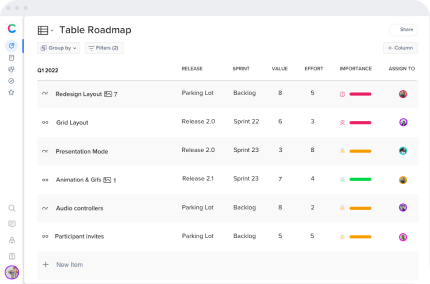What is a value proposition?
A value proposition explains the unique value a product delivers to its users. It describes how the product solves a problem, improves the user experience, or offers something better than existing alternatives. A value proposition is an essential part of a business’s marketing strategy because it’s designed to appeal to the target audience and influence their purchase decision.
A strong value proposition is clear, specific, and aligned with the target audience’s needs. It highlights the main benefits and differentiators that make the product stand out.
For product managers and marketing managers, the value proposition is the foundation for product strategy and communication. It helps teams stay focused on what matters most to users and ensures that every feature and message supports the core promise of value.
A good value proposition definition goes beyond slogans or catchy phrases. It provides meaningful information about what makes a product unique and valuable to its audience. It should be simple, well-written, and supported by a clear headline that communicates the main benefit at a glance.
Step-by-Step: How to Build a Standout Value Proposition
Building a strong, unique value proposition takes research, collaboration, and continuous refinement. For product owners, it is a process that connects user insights to strategic decisions. Here’s how to get started:
Step 1: Understand Your Audience
To build a strong value proposition, you first need to understand who you are creating it for. Start by developing detailed user research and personas based on real data from surveys, interviews, and analytics. This helps you see the world from your customers’ perspective and uncover what truly motivates them.
Define their goals, challenges, and decision-making factors. Understanding your target audience gives your team the insights needed to create a unique value proposition that resonates and feels relevant.
Step 2: Identify and Prioritize Pain Points
The next step is to identify your customers’ biggest pain points. Collect both qualitative and quantitative feedback from users, support teams, and analytics tools.
Focus on the most important problems your product can solve and the measurable value it can deliver. The stronger your understanding of customer pain points, the clearer your value proposition meaning becomes, and the easier it is to position your product effectively in the market.
Step 3. Define Your Unique Strengths
To stand out, you need to clearly define what makes your product different. Analyze your competitors and pinpoint what sets your solution apart. Highlight the features, outcomes, or experiences that make your product the best fit for your users.
This is where your unique value proposition takes shape. It is the clear promise that shows how your product delivers greater value than other options. A strong value proposition example could highlight faster results, a smoother user experience, or more meaningful insights, depending on what matters most to your audience.
Step 4: Craft a Clear and Compelling Statement
Bring your research together into a clear and concise statement that explains your product’s value proposition. Focus on simple, customer-centered language that clearly shows what your product does and why it matters. Avoid jargon and keep the message natural and relatable. A strong value proposition is easy to remember, connects with your audience, and builds confidence in your product.
Part of the goal of the value proposition is to show your potential buyers you are different from the crowd. While many businesses may offer the same services, talk about what makes you unique. Known as a unique selling point, it tells a potential customer that you have something others don’t offer or a better version of it. So, before you write a value proposition, take time to research your competitors.
Step 5: Test and Refine Continuously
A value proposition is never final. As your product and market evolve, your message should evolve too. Share your value proposition with users, stakeholders, and your team to gather feedback and uncover new insights.
Track how your message performs across different channels and use the results to refine and strengthen it. Continuous testing helps you confirm your assumptions, stay aligned with customer needs, and ensure your value proposition remains relevant, authentic, and effective over time.
Common Challenges in Value Proposition Development (and How to Overcome Them)
Defining and communicating a strong value proposition can be difficult. Many product teams face challenges such as misaligned stakeholders, unclear differentiation, and limited customer insight. When teams work in silos or use disconnected tools, it becomes even harder to maintain a consistent and meaningful message.
To overcome these challenges, it’s important to create a shared understanding of your product’s core value. Centralizing research, feedback, and customer insights helps everyone stay aligned. Encourage collaboration across teams through shared roadmaps and communication channels, and use flexible frameworks to refine your value proposition as your product evolves.
By continuously gathering feedback and adapting based on real user input, your value proposition remains relevant, impactful, and true to what customers need most.
Take the Next Step Toward a Stronger Value Proposition
Don’t let your product’s unique value go unnoticed. This is your moment to clearly define what makes your product stand out and connect that story to the people who matter most, your customers. With the right structure and focus, your team can align around a shared vision, sharpen your strategy, and communicate your value with confidence and clarity.
A strong value proposition can:
- Boost engagement and conversions by clearly showing how your product meets customer needs.
- Provide clarity about how your product or service delivers tangible benefits.
- Build trust and credibility by communicating real value in a transparent way.
- Strengthen team alignment so everyone works toward the same vision and customer promise.
As it’s best, a value proposition can boost engagement and converts more. It gives your audience detailed and precise information about how your project works. It shows how the service or product will benefit a customer. When the benefits are evident, the chances of conversion increase, more benefits come from the engagement a value proposition will generate. Build a product that truly connects with your audience and delivers meaningful results.
FAQ
What is the main purpose of a value proposition?
The main purpose of a value proposition is to convince stakeholders, investors, or customers that your product or service is worthwhile. It articulates your product’s unique benefits and differentiators, making it easier to attract investment, drive customer demand, and align your team around a shared vision.
What are the three key elements of a strong value proposition?
A compelling value proposition typically includes these three core elements:
- Target Customer: Who you serve.
- Problem or Need: The issue you solve.
- Unique Value: How your solution is better than others.
Clearly define each to make your message resonate.
Why is it important to test and refine your value proposition?
Testing and refining your value proposition ensures that your messaging truly resonates with your target audience and adapts to changing market needs. By gathering feedback and making data-driven adjustments, you increase the chances of attracting and retaining customers, and maintaining a competitive edge.
What Is a Value Proposition Example?
A strong value proposition example clearly communicates what a product offers, who it serves, and why it’s unique. For instance, a product management platform might say: “Empower your team to plan, track, and deliver products customers love and all this in one place.”
This example highlights the benefit (empowering teams), the audience (product teams), and the differentiator (a unified workspace).


